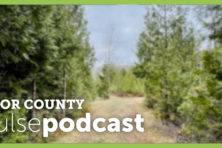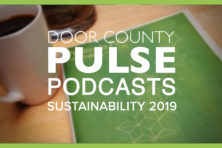2021 Sustainability Issue: The Power of Trees
- Share
- Tweet
- Pin
- Share
Water, sunshine, gravity, soil, biological diversity – these are all necessary to sustain life on Earth as we know it. Trees have their place in this pantheon of vital conditions and resources, but we also love them for their beauty and practical purposes. Surrounded as we are in Door County by a plentiful supply of woodlands and forests, we may take our trees for granted. In this year’s Sustainability Issue, we do not.
We’ve taken the Power of Trees as our theme to honor within these pages the contributions trees make to our world. We spotlight efforts to multiply and manage their numbers. We consider how they contribute to everything from urban landscapes to economies to homeopathic remedies. We highlight those things that threaten trees and honor species that have lost their fights. We show you how to plant your own trees properly and offer a glimpse into their hidden lives of communication – yes, trees do talk to each other.
Trees do so much more, of course. They inhale greenhouse gases and exhale the oxygen we breathe. They improve water quality, purify air, stabilize soil, provide jobs and supply us with building and paper products. They’re also vanishing. They cover about 30% of the planet, about half the estimate of what once covered the Earth. We lose them to farmland, toilet paper, timber and other human needs. Fires are also on the rise.
We’re fortunate in Wisconsin. Forty-six percent of Wisconsin is still forested, 48% of Door County. The majority of Wisconsin’s original forests were lost to agriculture in the south, logging in the north. In the United States, only 5% of old-growth forests still exist – forests generally described as having stood untouched for 200 years or more. About 1% of Wisconsin’s forests are still classified as old growth. Some of those exist here in Door County, including at Toft Point in Baileys Harbor.
Environmental sustainability means avoiding depletion of our natural resources. It means meeting our needs without compromising future generations’ ability to meet theirs. We can’t make the sun shine or control gravity, but we can be good stewards of the natural resources that sustain us.
Welcome to the Power of Trees.
BY THE NUMBERS
1/3
The amount of fossil-fuel emissions global trees reduce annually.
1
The number of days a large tree can supply oxygen for up to 4 people.
20%+
The amount of the world’s oxygen produced in the Amazon rainforest.
180 million
The number of Americans who get their quality drinking water from forested watersheds.
$1.5 billion
The amount of money New York City spent to buy thousands of acres of upstate land to preserve the forested watershed that supplies New York City’s drinking water.
10 degrees F
The temperature reduction that happens in a city where trees offer shading for area homes and streets, and where they can release water vapor at night through their leaves.
1 year
The amount of time it takes for 1 acre of mature trees to absorb the amount of CO2 produced by a car driven 26,000 miles.
25%
The amount an average household will reduce its heating and cooling energy consumption through carefully positioned trees.
12%
The decrease in crime in some city neighborhoods that had a 10% increase in tree canopy.
Every dollar
Spent on planting and caring for a community tree yields benefits that are two to five times that investment. These benefits include cleaner air, lower energy costs, improved water quality and stormwater control, and increased property values.
Source: Arborday.org



